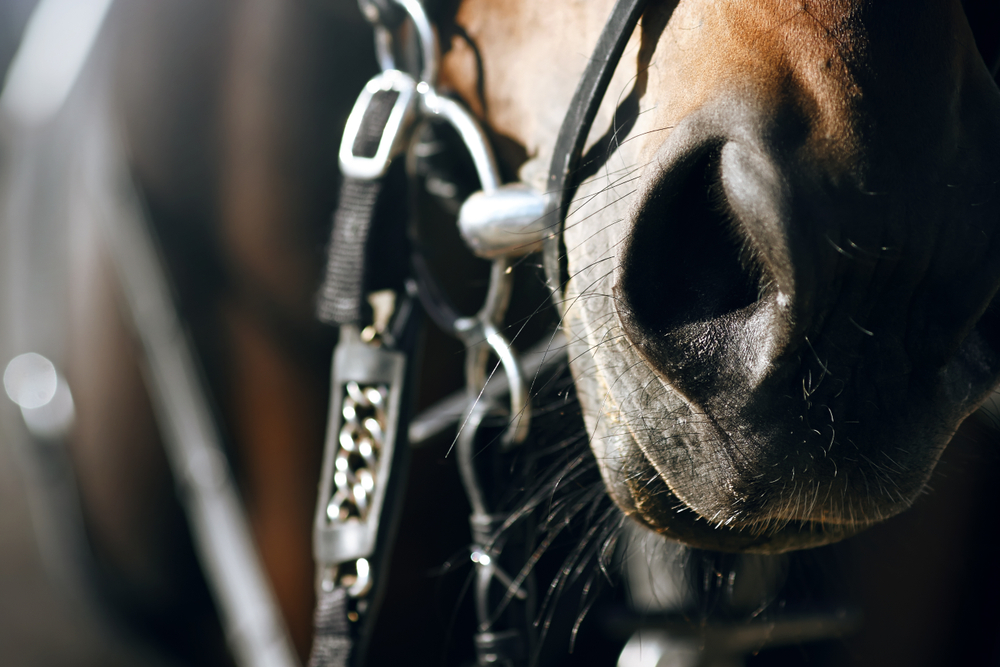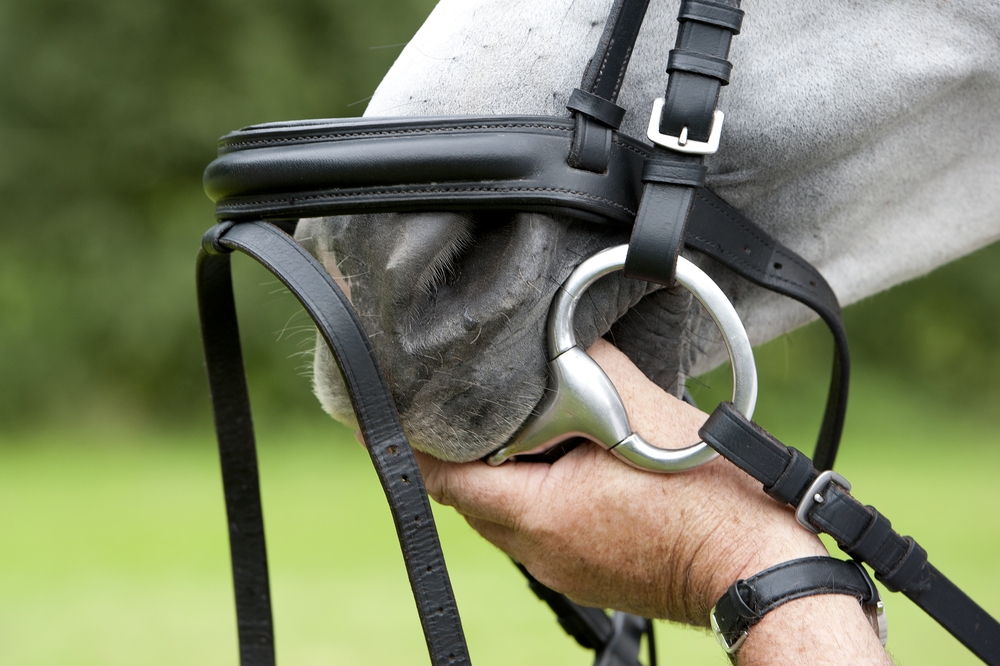- Your source for stall mats, rubber arena footing, arena harrows and arena dust control.

The bit sits in the horse’s mouth and acts as an interface between the rider’s hands and the horse’s mouth. Horses with sensitive mouths often become unhappy and dangerous to ride unless a comfortable bitting solution is found.
The perfect bit for a horse with a sensitive mouth is one that considers the individual horse’s mouth anatomy and relieves pressure over sensitive areas. A ported bit relieves tongue pressure. A mullen mouth bit is ideal for a low palate, and a hanging snaffle is best for bruised bars.
Horse’s mouths were not made for bits. Thus it’s not surprising that many horses are labeled sensitive and difficult to bit. The bitting solutions that work for individual horses are highly dependent on why the horse has a sensitive mouth.
Why Do Some Horses Have Sensitive Mouths?
Like humans, horses are individuals with unique anatomy, preferences, and history.
A horse may have a sensitive mouth due to past injuries or trauma relating to the bit; choosing a bit that relieves pressure over scars if a past injury results in scar tissue is vital. The most common areas to be scarred by the bit are the bars, lips, and tongue.
Horses will also differ in the shape and sensitivity of their mouths. Some horses have fleshy tongues and lips, leaving very little space for the bit, while others may have sensitive tongues or low palates.
These anatomical differences can present as mouth sensitivity. However, the bitting solutions will vary according to the underlying reason for bit sensitivity.
Which Bit Is Best For Horses With Sensitive Tongues?
Horses with thick fleshy tongues or sensitive tongues will often develop tongue evasions. They may stick their tongues out, put their tongues over the bit or try and pull it behind the bit.
Ported bits relieve tongue pressure by arching upward away from the tongue. They act on the palate, bars, and lips of the horse. Depending on the ring attachment, they may also introduce poll pressure.
Ported bits are traditionally regarded as harsh bits that apply excessive pressure to the hard palate of the horse’s mouth. However, Dwight Bennet of Damascus Equine has found that horses will only experience palate pressure if the port is more than 2″ in height.
has found that horses will only experience palate pressure if the port is more than 2″ in height.
Bomber’s Happy Tongue range and the KK Correction Bit
range and the KK Correction Bit are low ported bits designed for horses with sensitive tongues. Unfortunately, ported bits are not dressage legal.
are low ported bits designed for horses with sensitive tongues. Unfortunately, ported bits are not dressage legal.
Dressage legal competition bits that can work for a horse with a sensitive tongue are:
Avoid a mullen mouth or other straight bar bits, as these bits are designed to put pressure on the horse’s tongue.
My Horse Has A Low Palette; What Bit Would You Recommend?
Some horses have very low lying palates, while others have fleshy tongues and lips, leaving very little room in the mouth for a bit. Horses with low-lying palates will often throw their heads and star-gaze when rein contact is picked up.
With these types of horses, avoid thick bits and bits that act upwards on the palate. Single jointed snaffles and ported bits are a big no-no for horses with a crowded mouth.
The best bitting solution for a horse with a crowded mouth is a narrow bit acting downwards, like a double-jointed snaffle or mullen mouth bit:
Mouths characterized by fleshy tongues and lips do best when fitted with narrower bits. The thinner the bit, the harsher the pressure applied with the rein aids. A rider using a thin bit needs to have an independent seat and not rely on their hands for balance!
Loose ring cheekpieces should be avoided as they tend to pinch horses with fleshy lips.

Which Bit Is Best For Horses With Bruised Bars?
The bit is designed to lie in the mandibular interdental space, also known as the “bars” of the horse’s mouth. A correctly fitted bit won’t touch the horse’s teeth; it will lie behind the horse’s incisors and in front of its back molars.
The bars of a horse’s mouth may become bruised or damaged if the bit is too thick or if the rider rides with firm contact. In cases of severe bruising, it is prudent to give the horse time to heal. The horses are kept in ridden work by using a hackamore or other bitless bridle option.
The following bits are perfect for horses with sensitive bars:
- Bomber Ultra-Comfy Lock-Up Loose Ring Bit

- Nathe Mullen Mouth Bit

- Beris Filet/Baucher Mullen Mouth Thin Comfort Bar Hanging Cheek Snaffle

The mullen mouth bits are one of the gentlest bits currently on the market. A hanging snaffle or Boucher bit suspends the bit in the horse’s mouth, reducing bar pressure by applying pressure to the tongue and palate.
My Horse Is Hypersensitive To Bit Pressure; What Bit Will Work?
A few years ago, Heather Hyde from Neue Schule tackled a complex bitting issue.
tackled a complex bitting issue.
The horse would go fine for 2 to 3 days when first fitted with a new bit. On the 3rd or 4th day, he would be back to his old tricks and had even hospitalized previous riders due to flipping over backward.
Heather eventually realized that the problem was not the bit but with the horse’s oversensitivity to pressure. He could not tolerate more than three days in the same bit, as the pressure points would become more than his delicate nerves could handle.
After trial and error, Heather realized that the solution did not lie in a single bit but rather in establishing a bitting schedule.
The horse was given a variety of bits, acting on different parts of the mouth. The bit is changed every second day to avoid overstressing any part of his mouth. This was a novel but effective approach to bitting a highly reactive horse.
My Horse Has Teeth Problems; What Bit Must I Use?
No bit can solve teeth problems. Ideally, a vet and equine dentist would work together to solve your horse’s dental issues.
Some horses have chronic dental issues due to jaw misalignment or injury. These horses typically have complex mouth anatomy and require the expertise of a professional bit and bridle fitter to find the perfect bitting solution.
Conclusion
The bit must rest easily in a horse’s mouth without any excess pressure when not in use. When being used, it should apply just enough pressure to catch the horse’s attention but not enough to cause distress or injury.
The ideal bitting solution for a horse with a sensitive mouth is a bit that considers the reason for the horse’s sensitivity and relieves pressure in the affected areas of the horse’s mouth.
Sources
- https://asiakas.kotisivukone.com/files/geec2017.kotisivukone.com/Esitykset/Sensitive_equine_mouth_26_5_2017.pdf

- https://www.ncbi.nlm.nih.gov/pmc/articles/PMC7222381/

- https://damascusequine.com/wp-content/uploads/2017/08/AnOverviewOfBitsAndBitting.pdf

- https://nsbits.com/article/enlightened-bitting-managing-the-sensitive-mouth

- https://www.bitbankaustralia.com.au/allabouthorsebits/my-top-5-bits-for-a-fussy-mouth/

- https://www.bombers.co.za/product/classic-dee-happy-tongue/

- https://pferdesport.sprenger.de/shop/pferdesport_en/40454.html

- https://nsbits.com/products/mouthpiece/verbindend/verbindend

- https://pferdesport.sprenger.de/shop/pferdesport_en/40583.html

- https://www.bitbankaustralia.com.au/neue-schule-turtle-tactio-snaffle/

- https://www.cotswoldsport.co.uk/shop/index.php?main_page=product_info&products_id=467

- https://www.bombers.co.za/product-category/mouthpiece/flexible/moulded-mullen/

- https://www.bitbankaustralia.com.au/bombers-ultra-comfy-lock-up-loose-ring/

- https://pferdesport.sprenger.de/shop/pferdesport_en/40450.html


